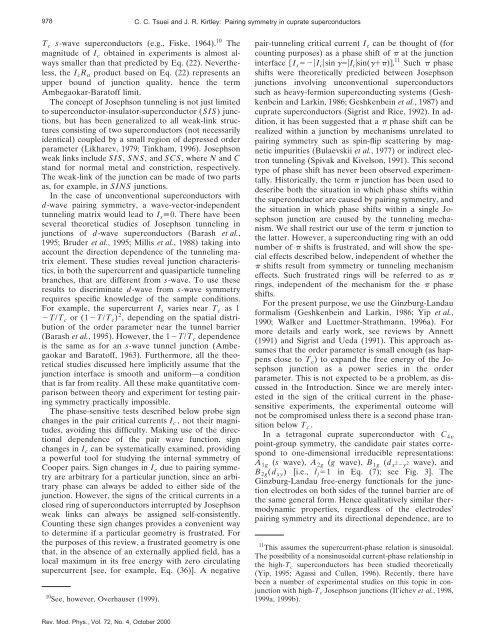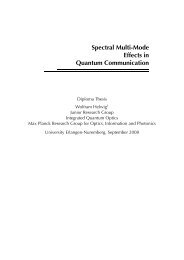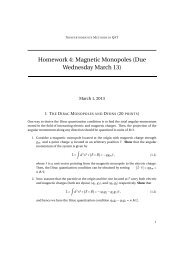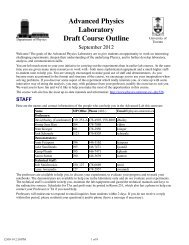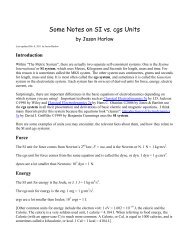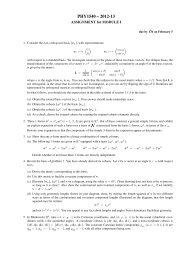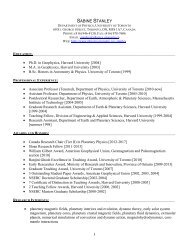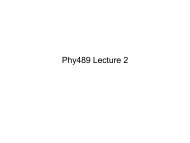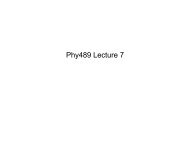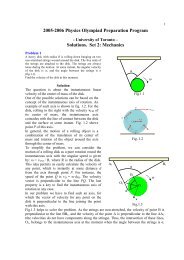Kirtley and Tsuei - Physics
Kirtley and Tsuei - Physics
Kirtley and Tsuei - Physics
You also want an ePaper? Increase the reach of your titles
YUMPU automatically turns print PDFs into web optimized ePapers that Google loves.
978 C. C. <strong>Tsuei</strong> <strong>and</strong> J. R. <strong>Kirtley</strong>: Pairing symmetry in cuprate superconductors<br />
T c s-wave superconductors (e.g., Fiske, 1964). 10 The<br />
magnitude of I c obtained in experiments is almost always<br />
smaller than that predicted by Eq. (22). Nevertheless,<br />
the I c R n product based on Eq. (22) represents an<br />
upper bound of junction quality, hence the term<br />
Ambegaokar-Baratoff limit.<br />
The concept of Josephson tunneling is not just limited<br />
to superconductor-insulator-superconductor (SIS) junctions,<br />
but has been generalized to all weak-link structures<br />
consisting of two superconductors (not necessarily<br />
identical) coupled by a small region of depressed order<br />
parameter (Likharev, 1979; Tinkham, 1996). Josephson<br />
weak links include SIS, SNS, <strong>and</strong> SCS, where N <strong>and</strong> C<br />
st<strong>and</strong> for normal metal <strong>and</strong> constriction, respectively.<br />
The weak-link of the junction can be made of two parts<br />
as, for example, in SINS junctions.<br />
In the case of unconventional superconductors with<br />
d-wave pairing symmetry, a wave-vector-independent<br />
tunneling matrix would lead to I s 0. There have been<br />
several theoretical studies of Josephson tunneling in<br />
junctions of d-wave superconductors (Barash et al.,<br />
1995; Bruder et al., 1995; Millis et al., 1988) taking into<br />
account the direction dependence of the tunneling matrix<br />
element. These studies reveal junction characteristics,<br />
in both the supercurrent <strong>and</strong> quasiparticle tunneling<br />
branches, that are different from s-wave. To use these<br />
results to discriminate d-wave from s-wave symmetry<br />
requires specific knowledge of the sample conditions.<br />
For example, the supercurrent I s varies near T c as 1<br />
T/T c or (1T/T c ) 2 , depending on the spatial distribution<br />
of the order parameter near the tunnel barrier<br />
(Barash et al., 1995). However, the 1T/T c dependence<br />
is the same as for an s-wave tunnel junction (Ambegaokar<br />
<strong>and</strong> Baratoff, 1963). Furthermore, all the theoretical<br />
studies discussed here implicitly assume that the<br />
junction interface is smooth <strong>and</strong> uniform—a condition<br />
that is far from reality. All these make quantitative comparison<br />
between theory <strong>and</strong> experiment for testing pairing<br />
symmetry practically impossible.<br />
The phase-sensitive tests described below probe sign<br />
changes in the pair critical currents I c , not their magnitudes,<br />
avoiding this difficulty. Making use of the directional<br />
dependence of the pair wave function, sign<br />
changes in I c can be systematically examined, providing<br />
a powerful tool for studying the internal symmetry of<br />
Cooper pairs. Sign changes in I c due to pairing symmetry<br />
are arbitrary for a particular junction, since an arbitrary<br />
phase can always be added to either side of the<br />
junction. However, the signs of the critical currents in a<br />
closed ring of superconductors interrupted by Josephson<br />
weak links can always be assigned self-consistently.<br />
Counting these sign changes provides a convenient way<br />
to determine if a particular geometry is frustrated. For<br />
the purposes of this review, a frustrated geometry is one<br />
that, in the absence of an externally applied field, has a<br />
local maximum in its free energy with zero circulating<br />
supercurrent [see, for example, Eq. (36)]. A negative<br />
10 See, however, Overhauser (1999).<br />
pair-tunneling critical current I c can be thought of (for<br />
counting purposes) as a phase shift of at the junction<br />
interface I s I c sin I c sin(). 11 Such phase<br />
shifts were theoretically predicted between Josephson<br />
junctions involving unconventional superconductors<br />
such as heavy-fermion superconducting systems (Geshkenbein<br />
<strong>and</strong> Larkin, 1986; Geshkenbein et al., 1987) <strong>and</strong><br />
cuprate superconductors (Sigrist <strong>and</strong> Rice, 1992). In addition,<br />
it has been suggested that a phase shift can be<br />
realized within a junction by mechanisms unrelated to<br />
pairing symmetry such as spin-flip scattering by magnetic<br />
impurities (Bulaevskii et al., 1977) or indirect electron<br />
tunneling (Spivak <strong>and</strong> Kivelson, 1991). This second<br />
type of phase shift has never been observed experimentally.<br />
Historically, the term junction has been used to<br />
describe both the situation in which phase shifts within<br />
the superconductor are caused by pairing symmetry, <strong>and</strong><br />
the situation in which phase shifts within a single Josephson<br />
junction are caused by the tunneling mechanism.<br />
We shall restrict our use of the term junction to<br />
the latter. However, a superconducting ring with an odd<br />
number of shifts is frustrated, <strong>and</strong> will show the special<br />
effects described below, independent of whether the<br />
shifts result from symmetry or tunneling mechanism<br />
effects. Such frustrated rings will be referred to as <br />
rings, independent of the mechanism for the phase<br />
shifts.<br />
For the present purpose, we use the Ginzburg-L<strong>and</strong>au<br />
formalism (Geshkenbein <strong>and</strong> Larkin, 1986; Yip et al.,<br />
1990; Walker <strong>and</strong> Luettmer-Strathmann, 1996a). For<br />
more details <strong>and</strong> early work, see reviews by Annett<br />
(1991) <strong>and</strong> Sigrist <strong>and</strong> Ueda (1991). This approach assumes<br />
that the order parameter is small enough (as happens<br />
close to T c ) to exp<strong>and</strong> the free energy of the Josephson<br />
junction as a power series in the order<br />
parameter. This is not expected to be a problem, as discussed<br />
in the Introduction. Since we are merely interested<br />
in the sign of the critical current in the phasesensitive<br />
experiments, the experimental outcome will<br />
not be compromised unless there is a second phase transition<br />
below T c .<br />
In a tetragonal cuprate superconductor with C 4<br />
point-group symmetry, the c<strong>and</strong>idate pair states correspond<br />
to one-dimensional irreducible representations:<br />
A 1g (s wave), A 2g (g wave), B 1g (d x 2 y2 wave), <strong>and</strong><br />
B 2g (d xy ) [i.e., l j 1 in Eq. (7); see Fig. 3]. The<br />
Ginzburg-L<strong>and</strong>au free-energy functionals for the junction<br />
electrodes on both sides of the tunnel barrier are of<br />
the same general form. Hence qualitatively similar thermodynamic<br />
properties, regardless of the electrodes’<br />
pairing symmetry <strong>and</strong> its directional dependence, are to<br />
11 This assumes the supercurrent-phase relation is sinusoidal.<br />
The possibility of a nonsinusoidal current-phase relationship in<br />
the high-T c superconductors has been studied theoretically<br />
(Yip, 1995; Agassi <strong>and</strong> Cullen, 1996). Recently, there have<br />
been a number of experimental studies on this topic in conjunction<br />
with high-T c Josephson junctions (Il’ichev et al., 1998,<br />
1999a, 1999b).<br />
Rev. Mod. Phys., Vol. 72, No. 4, October 2000


